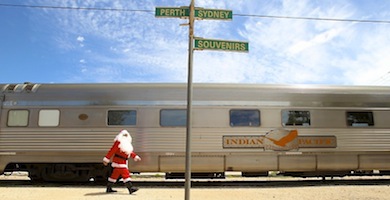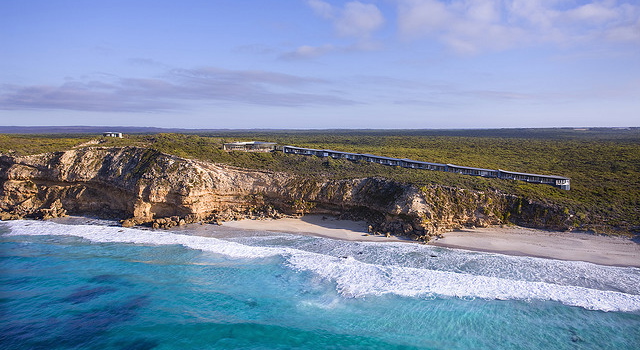Australia's Wild West
With scenery ranging from the dramatic deserts and the mystical beauty of the Kimberley in the north, to the wind-blown beaches and dense forests of the south, the state of Western Australia is a multifaceted, endlessly appealing destination. Because of Australia’s vast size, “WA” is also a continent away from the distinctly different pace and places that make up the more widely traveled eastern seaboard and well-known destinations like Sydney and Melbourne. Using the capital city of Perth as a base, my recent travels to the region’s wild heart reveal experiences perfect for adventurous souls.
Kings Park
You don’t even have to leave the city to enjoy the wonders of nature. Perth is home to Kings Park and Botanic Garden, the largest city park in the southern hemisphere (1,000 acres), and the most visited sight in all of Western Australia. The park has a mystical past according to the Aboriginal Nyoongar people, who held wedding festivals there. Even more enjoyable than the views from the stark glass-and-steel aerial path are the botanical exhibits, with 2,000 different species of plants represented, including the bottle-shaped boab trees, and fragrant peppermint eucalyptus trees. There’s also a wildflower festival in spring. One of the best ways to see the Park and learn about both its history and its flora is by taking a tour with Kings Park Indigenous Heritage Tours.
Swimming with the Rockingham Dolphins
This isn’t your average tourist trap dolphin swim. Instead, the knowledgeable divers at Rockingham Wild Encounters take visitors out into the coastal waters near Perth searching for pods of wild dolphins. When they spot a group, it’s into the water, where you float and watch as these marvelous sea-going mammals frolic around you, often coming quite near for a closer look. (Since these are wild animals, no touching or feeding is allowed). On the way back to shore, you will learn about the individual stories of the dolphins you saw (the guides recognize most of them by sight), their daily lives, and the environmental threats they face. It’s a great combination of adventure and eco-education.
Rottnest Island
This Rottnest Island nature reserve lies 12 miles off the coast from Perth, and is a weekend playground for city dwellers. The Rottnest Express Ferry leaves from both Perth and nearby Fremantle, and bike rentals can be included in the ticket. Europeans first discovered Rottnest in 1696, and misnamed the island when a Dutch captain mistook the marsupials here, cute kangaroo-like creatures called quokkas, for rats. Hence its name, which means “rats’ nest.” Apart from the wildlife, which also includes whales, dolphins and countless tropical fish species, there are secluded coves for swimming, shipwrecks to snorkel and explore, and extensive cycling paths, as well as a selection of seafood restaurants like Aristos.
Bushtucking
You might not have Crocodile Dundee along for the trip, but you can still go bushtucking (camping, for non-Ozzies) for a day with Bushtucker Tours. An experienced guide will meet you at the mouth of the Margaret River where it flows into the Indian Ocean, and take you canoeing along the lazy inlets of the stream, explaining the history of the region, its Aboriginal culture, and the avian wildlife you’re sure to spot. Lunch is a picnic of Aboriginal and wild foods like the antioxidant-rich bush lime, and the surprisingly delicate witchetty grub (yes, it’s a larva). It’s a great way to get to know the region while enjoying a bit of soft adventure.
Ngilgi Caves
The limestone bedrock that forms the Margaret River region (and is partially responsible for the lovely acidity of the fine wines produced there) conceals an enormous network of underground caves, including the Ngilgi Cave in Yallingup. Ngilgi is an impressive collection of prehistoric stalactite, stalagmite and shawl formations formed over aeons by water filtering through the ground. Spelunkers descend forty-five meters below the surface and can take guided tours, or choose to follow any number of paths through the network. Just be sure to stop in the main cavern, which is like a cathedral of stone and has amazing acoustics.
Cape to Cape Track
The Cape to Cape Track is a path that traces 80 miles of spectacular coastline in the Margaret River region between the lighthouses at Cape Naturaliste in the north and Cape Leeuwin in the south. Along the way, walkers can marvel at the massive red rock formations that line the rugged coast. There are pristine, deserted beaches, and inland loops that lead into towering karri tree forests. Bring good shoes because, though the track is paved in parts, much of it is sandy or stony. The whole walk takes about a week, but is broken up into sections that can be taken at an easy pace — a day or half-day — as part of your trip, and there are multiple hotels, like Injidup Spa Retreat, along the way. As a bonus, if you plan your trip between September and December, you’ll catch glimpses of migrating humpback and blue whales.
Unless otherwise noted, all images courtesy of Tourism Western Australia.
Latest posts by Eric Rosen
- Revenge Of The Merlot! Learn About Wine Sets the Record Straight - May 13, 2010
- Australia's Wild West - March 9, 2010






Need short-term housing? We can help you locate it fast. Tap into our extensive network of temporary housing providers to locate furnished apartments in US and Canada.